Notes phytochemist. Banana skin strikes back
The banana is great, and the peel is even more ...
( magazine "Technology - youth" No. 8 for 1986)
Peel banana got the unenviable fate. If the peel of apples is used at least to get apple pectin , then in the case of a banana peel, there is only one way - to the dumpster ... But the thing is not easy, it will help to slip, and ethylene will highlight for ripening. And besides, with such a simple and straightforward thing as a peel are connected global things such as anti-nutrients, non-lethal drug bananadine and blackening of the skin from sunburn. In general, I propose to understand and restore phyto justice.
For details - under the cat.

By the way, despite the fact that almost from the 19th century, banana peel has been used as a "national" symbol of gliding (I would probably even sell CIATIM with a banana logo), as far as I know, there has not been serious research on the mechanism of this phenomenon. People (see below) even ships were lowered from the stocks using a banana peel, and only Japanese from Kitasato University came up with an estimate of the tribological properties (the coefficient of friction there, something else on trifles). These are Kiyoshi Mabuchi and associates (Kensei Tanaka, Daichi Uchijima, Rina Sakai). Apparently, at one point in 2012, after eating sake, the guys took up the bananas , so much so that they gained the Ig Nobel Prize in 2014 (in general, I tend to think that a scientist who cannot do a funny or funny thing in his specialty is a “not real” scientist) .
What exactly did they do? First, they measured the coefficient of friction between the surface (wooden / concrete floor) and the boot and traced how the banana peel influences this coefficient. It turned out that the average friction coefficient of a banana over linoleum was 0.066 (for a banana, the hardwood flooring was 0.083), which is pretty good, for comparison, Teflon (with a friction coefficient of 0.04), ice (about 0.05) or other lubricated surfaces. For comparison, the coefficient of friction of rubber on concrete is 1.02. At the same time checked the "tendency to slip" in apple peel, lemon peel and mandarin. For apples, the friction coefficient was 0.105. For mandarin - 0.225 (the mandarin peel is about as slippery as the wooden floor itself. Secondly, the Japanese installed a sliding mechanism. It resembles the process of using Moment Gel glue, in which cyanoacrylate is contained in microcapsules, which break at the moment of squeezing and thus start the polymerization of glue (due to contact with moist air). In a banana, banana peel follicles act as microcapsules, and glue lubricant - follicular gel of polysaccharides and proteins (component of plant tissue). In the normal state, polysaccharides in the follicles resemble a gel, and when crushed they form a slippery sol.

The peel of an apple / lemon / mandarin contains so-called. follicular gel in quantities much smaller than the banana peel, so the friction coefficient of these materials is very different from the banana. The Japanese called this mechanism a follicular gel lubricant and predict that in the future their research could give impetus to the development of a whole class of vegetable lubricants of a similar structure.
To the note : one of the banana-skinned ones is the Internet fallacy that ships are still being launched in India with the help of thousands of crushed bananas. It turned out not to be lowered, but not Indians, but Americans, during the Second World War (and bananas because less than any other lubricant)
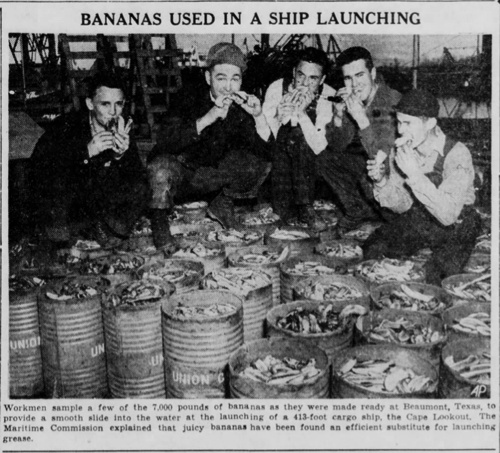
The second characteristic feature of the banana peel after the ability to slide, is the ability to publish an indescribable and unique banana flavor.
What do you smell in my ...
If you ask the average citizen to describe the fruit smell of a banana, then with a high degree of probability the answer will be "smells like banana". The aroma is unique and unlike anything. In the perfume industry, banana notes are not particularly popular due to the complexity of the synthetic repetition of the composition of natural essence. There are far fewer compositions with the use of banana notes than, for example, with an apple or citrus fruits, and there is no such thing where a banana is the main component - not at all (well, or I am not well informed in perfume novelties).
I think many knew they guessed that the whole banana flavor was concentrated in the peel. It is a mixture of about 50 chemical compounds. The picture under the spoiler shows the "full display":

In this and specific case, 43 compounds were found in the extract, of which 16 are alcohols, 20 ethers, 2 aldehydes, 4 ketones, 1 acetal. The maximum content falls on 2-pentanone, 2-pentanol, butanol, isobutyl acetate, isoamylacetate, 2-pentanol acetate, 2-methyl-1-propanol. In the process of ripening a banana in the peel, the content of such esters as isopentyl acetate and isobutyl acetate increases. According to many studies, it is believed that the most volatile components in green bananas are aldehydes, but in the yellow ripe ones - ethers. Therefore, esters are considered the main carriers of "banana flavor." The simplest synthetic fragrance "banana" (found in household chemicals sometimes) is usually a mixture of isobutyl acetate and isoamylacetate. But you can imagine (looking at the table above) how far it is from the smell of a live banana.
To the note : one time a rather persistent rumor went about the fact that the aroma of a banana helps to lose weight. The whole case was based on an article 25 years ago, in which an experiment was described, during which people who inhaled fruit flavors before eating could lose weight. The press and various resources devoted to the issues of healthy lifestyles / nutrition, etc. were repeatedly referred to this article. In fact, Mr. Hirsch (the author of the article mentioned above) just started to release his own dietary supplement (banana-like powder for sprinkling over cooked dishes, read “gluttonous repellent”) and successfully sold it. BAA was called Sensa , and was quickly removed from the market after the FTC (the US Federal Trade Commission) fined the manufacturer for false statements about its effectiveness. Nevertheless, this bike continues to walk on the Internet until now.
Due to the ability to effectively give banana flavor products peel is actively used as a "fragrance". For example, in the process of making a special vegetarian dessert on the grill:

For cooking you need a bunch of bananas and a bar of chocolate. Bananas need to take such as at number 8 in the picture.
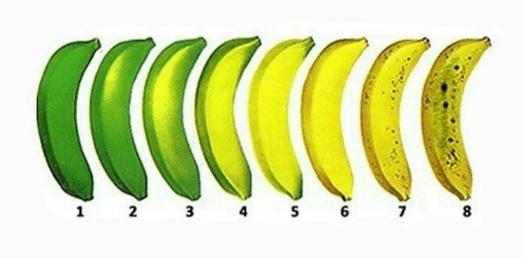
Cut the skin of a banana, so as to get a "pocket", cut into half the flesh. Break off a row of chocolate bars and divide it into 6 parts. That is how much chocolate fits in a big banana. We place the bananas in the grill on the grill grate upwards, and if the coal is already burned, then right on the coal. We control the cooking process. First, the outer skin will begin to darken and the core will give juice. Then the core starts to soften and the chocolate melts. Complete melting of chocolate indicates the readiness of the product. Banana dessert is ready. Putting it on a plate and serving it, there is, by the way, a nicer teaspoon :)
Banana smell in cooking is best suited for a variety of vegetarian desserts or sugary drinks (including tinctures). Although in some Asian countries with a banana peel they prepare both beef and tough mutton (including spreading the meat on a "pan" of banana peel). You can cook rice in such "containers".

Well, in the end can you and so is? Hindus because their chutney cooked from the rind. Read to the end - it will be clear, you can or can not eat. For now - a minute of official news under the spoiler.
“The banana peel is tastier and healthier than the banana itself. No one knows about it, because it has never tried,” the “ absurdopedist scholars ” tell us. So, we ate. And even in the news this fact was fixed ...
Since, incidentally, the conversation went "for food", it is impossible not to mention the white threads that are on the inside of the peel and are much loved by no less than a banana.
Phloem
I often watch a picture of a young mother watching a child eating a banana, the instructive tells him “don't eat skin”, and the child is trying to eat white loose fibers of the peel at this time. For some reason, many absolutely not justified believe that these fibers are harmful. And in fact, this is nothing more than those very coarse dietary fibers that many people buy "to improve intestinal motility and eliminate digestive waste." In spite of the fact that in the article about the green banana, I briefly explained why resistant starch from unripe bananas is better than dietary fibers, for those who don’t like and cannot eat unripe bananas, the peel fibers are a pretty good compromise. The scientific name of these white edible threads is phloem .
Phloem (from the Greek. Φλοῦς - bark) is the same as phloem - the conducting tissue of vascular plants, along which transport of photosynthesis products to parts of the plant in which it does not occur: underground parts, growth cones, flowers, fruits, etc. Together with xylem (wood), providing the transport of water and mineral salts, forms conductive beams.
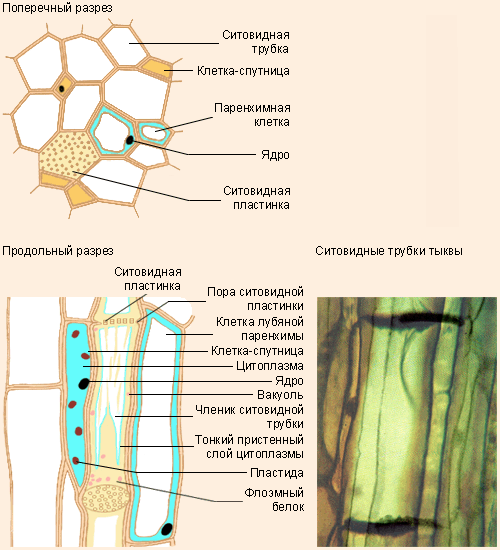
So, in general, phloem is completely edible, and banana phloem still contains more dietary fiber than other fruits. No one has any objections to the fact of using apples and pears with their skins. Another thing is that the thickness is different and slightly different composition. But in general, no one will eat only "conductive fibers", so this will not deal a blow to the diet. Although from the point of view of an inventive approach, any banana tends to eat along with the peel (like the same apple). And here there is even some success, moreover, it is expected - from the Japanese .
The invention, or rather the special agrotechnical approach ( banana bonsai ) to the cultivation of bananas belongs to the Japanese agricultural (!) research (!) Company D & T Farm, whose employees managed to bring a banana with edible peel ( Mongee variety). The technique there is something like this: seedlings of banana bushes that have grown to a certain level are frozen at -60 ° C. Then the bushes are thawed and transplanted. Due to temperature stress, the fruits begin to grow faster, and the skin texture becomes similar to lettuce leaves - very thin and pleasant to taste. The taste of new bananas is sweeter than usual - each one has about 5 grams of sugar more (by the way, because of this method of cultivation, the release of volatile components responsible for the banana flavor is greatly aggravated). Why are these bananas still not on sale? But because the technology is very expensive, and each such banana (a couple of dozen of which goes to Japanese stores) costs about $ 6
On the whole, not everyone will like the complete disappearance of the peel on bananas, at least those who sit tightly on the well-known drug "bananindine", which is prepared from the phloem threads mentioned earlier, will protest. In order not to shine - all under the spoiler.
I remember back in school time there was a “city legend” about the fact that if you scrape fibers from the inside of a banana peel (taken from 3 kg of bananas), boil them until brown, and then smoke it, then you can get an indescribable profit. I do not know if anyone tried to carry out this procedure to the end, but ... But with the advent of the accessible Internet, it was possible to find out where this urban legend came from.
It all started with the fact that in March 1966, the singer Donovan's hit " Mellow yellow " was suddenly released on smoking banana peel.
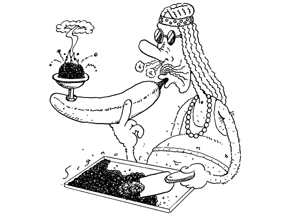
She added fuel to the fire and the alternative newspaper (samizdat) “The Berkeley Barb”, which published a satirical article on its pages in 1967, stating that smoking dried banana peel can be drunk (according to the publication’s information, its action is similar to opium with some fragments of psilobicin). Apparently, when publishing, they forgot to add the <... sarcasm ...> <... / sarcasm ...> tag.
Samizdat-culture in the West is traditionally strong, a domino effect poet in the same 1967, bananadine was described in an article in the New York Times Magazine entitled “Cool Talk About Hot Drugs”.
Well, surprisingly, the people took what was written seriously. Students became the pioneers of banana peel smoking and the trend found, as they say, viral popularity. As a joke, one of the congressmen of the state of New Jersey presented two new acts for consideration by the Congress - “The Act of Exposing and Reporting on Other Strange Fruits of 1967” and “The 1967 Banana Banking Act. Banana sellers were seriously alarmed (“suddenly banned”) and asked the FDA to ask about the hallucinogenic effect of banana peel. After lengthy and thorough research, a verdict was announced - something like "bananas are an excellent source of potassium and fiber, but definitely not from hallucinogens." And the maximum that you can get about smoking "jam from banana skins" - nausea and carbon monoxide poisoning from smoke.
This meme found a second life after the publication in 1970 of the book by William Powell “The Anarchist Cookbook”, which describes how to take home without any laboratories, higher education, etc.) various useful items — from homemade bombs to LSD. The recipe of Musa sapientum Bananadine "fine black powder of banana peel, suitable for smoking" was also there:
Buy 15 pounds of ripe yellow bananas. Peel all 15 pounds and eat the pulp. Leave only the skins. Clean the inside of the peel with a sharp knife and collect all the substance. Put all the collected substance in a large saucepan and add water. Boil for 2-3 hours until you get the consistency of a hard paste. Put the pasta on a baking sheet and dry in the oven for 20 minutes or 2 hours. Get a dark powder, about a pound of bananadine. Usually the effect is felt if you smoke 3-4 cigarettes with bananadine.
In spite of the fact that this move was thought out (= flash mob) in order to focus on the ethics of the illicit manufacture of psychoactive drugs and the prosecution of those who took them, the effect was exactly the opposite. On the post-USSR territory, because of the iron curtain, this trend hit only in the early 90s, but nevertheless, a couple of hundreds or thousands of people scratched their skin in their lifetime :) For those who read what I wrote, I still do not understand , I will say as a phytochemist, that “jelly from phloem” is as psychoactive as jam from oak bark "from the bast of the oak" (a reasonable clarification from Squoworode ). The maximum that can be obtained is carbon monoxide poisoning.
Remembering the beatniks, the hippies and everything psychoactive, it’s not a sin that will return to the chemical characteristics of the peel.
Why does the skin turn black?
Before proceeding to the consideration of the mechanism of darkening (blackening) of the peel, I would like to tell you about an interesting feature inherent only in the peel of a banana. To begin with, the degradation of chlorophyll, as is known, is one of the reasons for the autumn color change of foliage on trees and the coloring of ripe apples and pears. Usually in such cases are formed tetrapyrrole, not capable of fluorescence. And here again shows the unusual banana and its inherent banana peel. In ripening bananas, chlorophylls disappear, turning into unique fluorescent catabolites (fluorescent chlorophylls catabolites, FCC), causing yellow bananas to glow blue when observed under ultraviolet radiation.

The authors of the study found that among the decomposition products of chlorophyll there is a fluorescent chlorophyll catabolite 56 (FCC-56), which in the process of maturation turns into a catabolite FCC-49 . In this way, the banana peel, as it signals the change of stages from "mature" to "rotten."
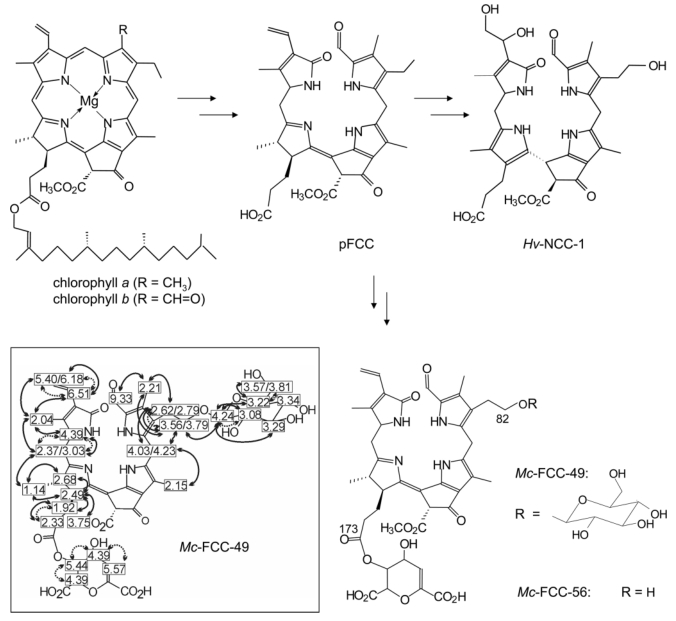
Researchers suggest that this mechanism allows animals that can see light in the ultraviolet spectrum ( tetrachromates and pentachromats ) to more easily detect ripe bananas. Although it may be useful to people, especially those who have collected a portable UV lamp of "black light", as described in the article How to escape from "hares". Instructions for anti-UV method.
The picture shows a diagram showing the relative amount of fluorescent catabolites (FCC) in extracts from the peel of an unripe green banana, fresh ethylene-treated banana (day 0) and ethylene-treated banana, which ripened from 1 to 5 days in storage at room temperature

With the identification figured out, now you can safely go to the enzymes. So, as you know, banana peel tends to darken, and darkening is not associated with a deterioration in the taste of a banana inside, but on the contrary - for most consumers (except those who are prescribed a green banana ). The ongoing process is nothing more than a so-called. enzymatic browning (eng. enzymatic browning ). This process is observed in fruits / vegetables and even seafood (shrimp, lobster and crabs). On the one hand, the process seems to damage and spoil the presentation, but on the other, if it were not, we would not know the color / taste of tea (including the one that is Ivan-tea, it is now fashionable to ferment) coffee, chocolate. Darkening is a natural natural process (“nature paints.” The polyphenols already familiar to my regular readers act as a basis for “colors” on the vegetable “canvas.” I already cited their detailed classification in the article Phytochemist Notes. Persimmon when describing natural antioxidants. And Various enzymes, for which polyphenols are substrates, act as “brushes.” As an initiator of the enzymatic browning mechanism, any process that causes the destruction of plant cells can act. In a banana ozhure, as banana ripening in the cell membranes begin to subside (due to dissolution of the pectin ). The picture below shows SEM-photograph of the cell walls "aging" banana.

In a green banana, there is no noticeable degradation of the cell structure (option a) in the picture). With the onset of yellowing of the peel (Figure c), small tears in the cell tissue become noticeable. Before destruction, there is some thickening (swelling) of partitions in the cell walls (options c) and d) in the picture). Gradually, the boundaries between the cells become fuzzy, which is associated with an extensive loss of cell integrity and the subsequent release of cell contents (as in the crush of the Japanese experiment). And at the yellow skin stage, the cells were completely destroyed and the cell wall structure became heterogeneous (variants e) and f) - for a banana ripening at elevated temperature). The disappearance of an ordered cell structure at the yellow skin stage is caused by the aging process. It is believed that aging with violation of the integrity of the cell membrane allows phenolic compounds (for a banana it is dopamine, leukodelphinidin, leukocyanidin ) in the vacuole of the cell to come into contact with enzymes like polyphenol oxidases. Polyphenol oxidases are a class of enzymes that were first found in fungi and widely distributed in nature. Apparently, they are found in plastids and chloroplasts of plants, although they freely exist in the cytoplasm of aging or ripening plants. Polyphenol oxidase is believed to play an important role in plant resistance to microbial and viral infections and adverse climatic conditions. In the presence of oxygen from air, the enzyme catalyzes the first stages of the biochemical transformation of phenolic compounds with the formation of quinones, which undergo further polymerization with the formation of dark insoluble polymers called melanins. Melanins form protective areas with antimicrobial properties, and thereby prevent the spread of infection in plant tissues. An example of the formation of melanins from simple polyphenol, tyrosine, is shown in the figure below:

: , , / , . , , , . , . Those. — , , , , . , , ...
, . , : . (). , pH (). ( <5) (> 8) . " ?". — (, ..) ( ) .
1) 2 :
1%
0,75%
0,75%
2) 5 /.
3) (3% O 2 + 10% CO 2
. :
1% 40
or
2% + 0,5% 1%
or
0,5-1% + 0,1-0,5% + 0,005-0,02%
. . , . . , .
, - . — " banana tattoo ". , . , . , , .
- :
Stephan Brusche (aka iSteef )
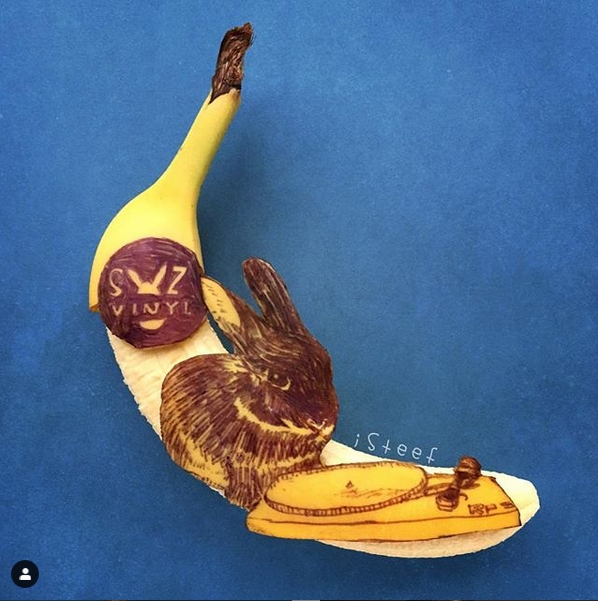

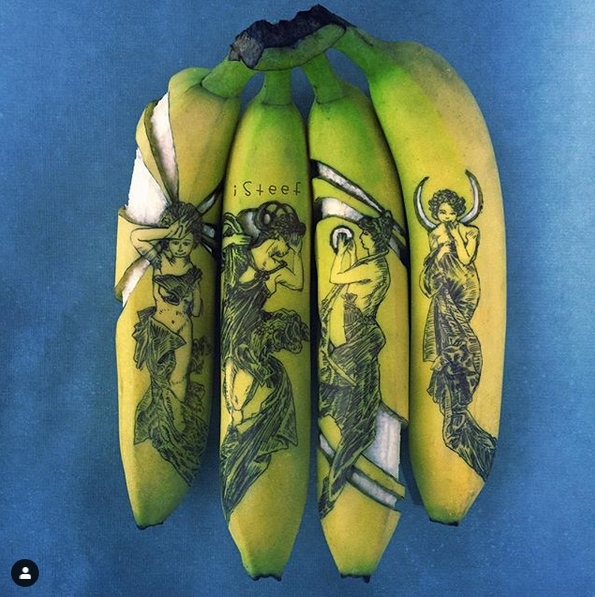
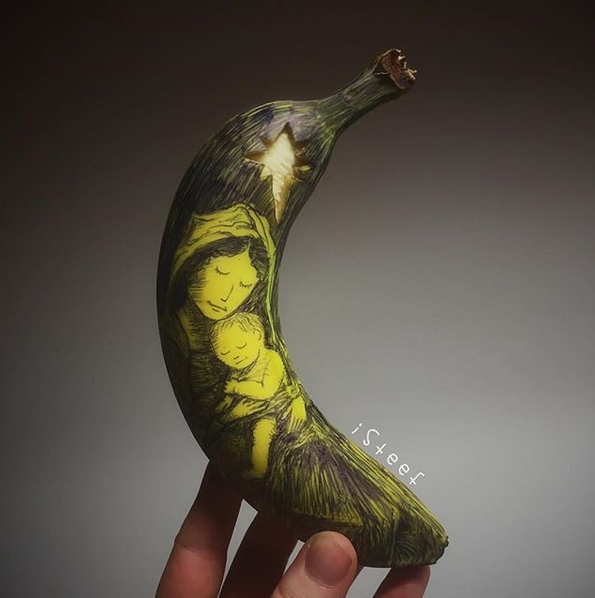
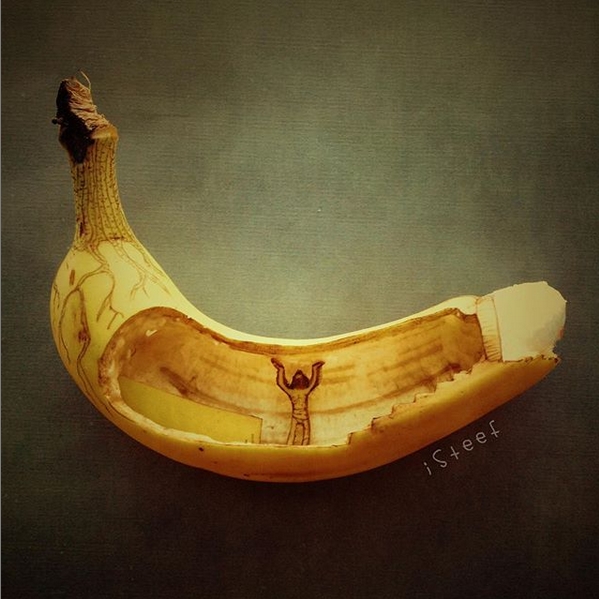

EndCape . 40- .
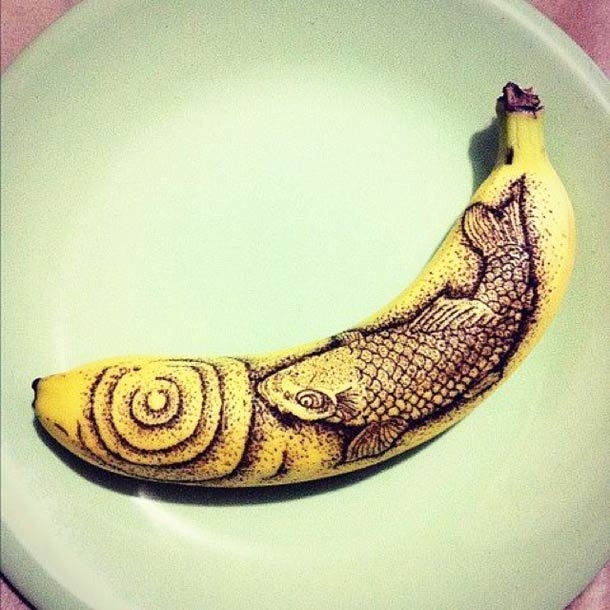


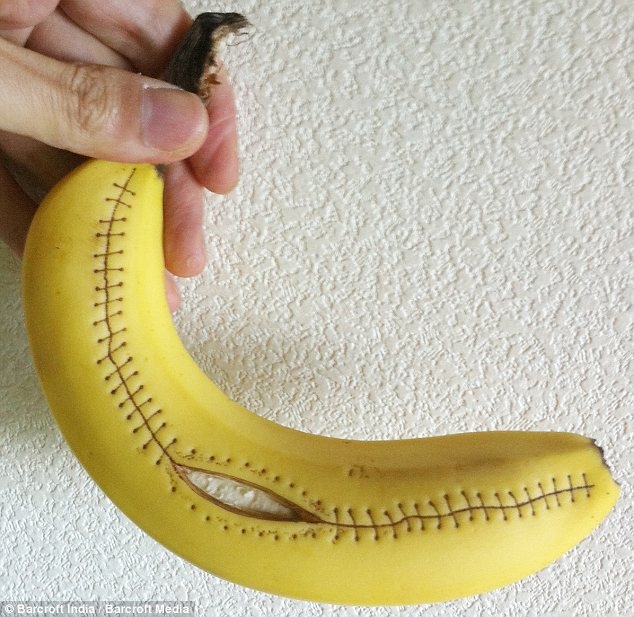
RitaColt aka Honey
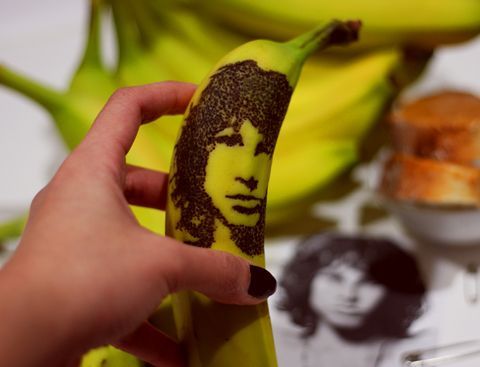
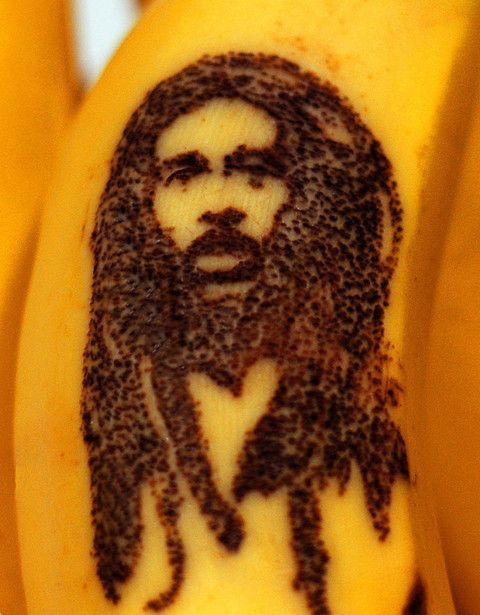
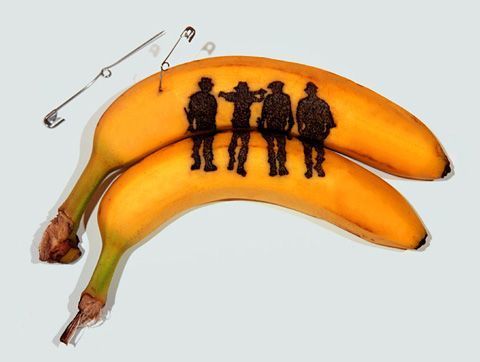

Jun Gil Park - , , . ( ) — , . ...


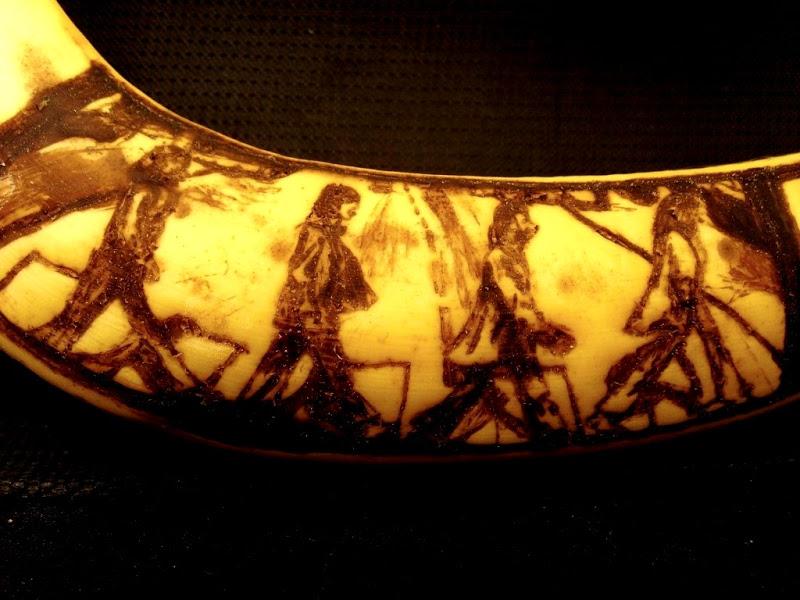
, (Phil Hansen), – , . " ", " Tattoo a Banana: And Other Ways to Turn Anything and Everything into Art " (" ").

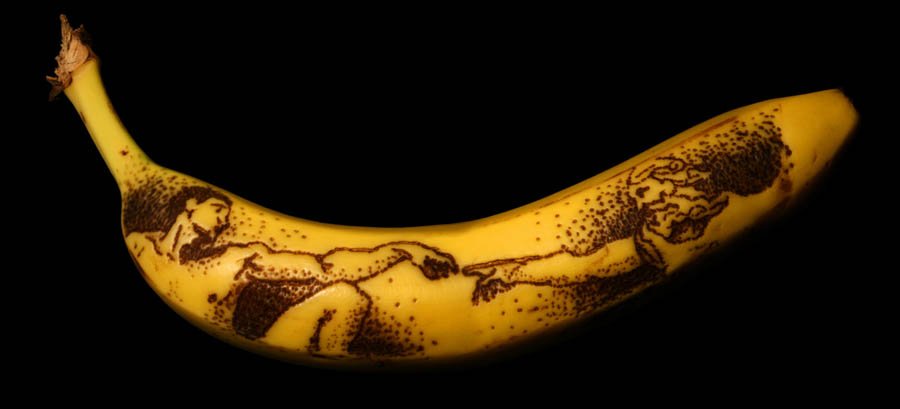
I think no one, after watching there is no doubt that the banana peel is as valuable as the banana itself. And in order to destroy some of these illusions and substantiate at least somehow the fact that the peel is thrown into the garbage, I will describe for some reason the peel is harmful and cannot be eaten (at least raw) from the point of view of phytochemist.
Anti-nutritional substances
Wise nature, unlike a person (like such a "talented" bioherakera), approaches the solution of any task in an incredibly complex way. It is not surprising that many talented engineers and scientists consider beings created by nature, reaction mechanisms, etc., as the standard of excellence. (therefore it remains only to work hard). So, in the process of evolution, most plants have developed their own defense mechanisms against eating by animals and insects. Including with the help of endogenous "repellents". In the foreign literature, these compounds are called antifeedants (English - antifeedants) and are organic compounds that prevent animals or insects from eating plants. As an example, pine rosin, garlic allylmethylsulfide and the like can be cited. Currently, many of the anti-fidants are used as biopesticides, synthetic analogues of natural compounds have allowed the development of new insecticidal preparations. As an example, pyrethrin from chamomile, on the basis of which a whole class of compounds called pyrethroids has been synthesized, has been synthesized. What is bad for a cockroach is good for a person. Therefore, it is not surprising that a person actively uses many plants containing anti-fidants as spice and aromatic additives (spices). You can recall the mustard and horseradish, which, in the event of damage / pressure, begin to release sharp oils containing glucosinolates .
Recently, a similar definition has appeared in human dietetics and nutrition. Such substances are called antinutrients (anti-nutritional substances or anti- fencer , as it is more convenient for anyone to say). Antinutrients are natural or synthetic compounds that inhibit the absorption of nutrients.
Both antinutrients include tannins and lectins (potential anticancer drugs from black dots on a banana peel, which I wrote about in the last article) and many other components (for example, enzyme inhibitors, dietary fiber, chelating agents, proteins, etc.) . On the one hand, for a person who lives under the auspices of "green" eco-food balance is important in everything. And in the absolute majority of cases, for the post-USSR countries, the proverb plays the role of "not to be fat - to be alive." Therefore, pectins are good for us, that marmalades are marketed, and blueberries with its antioxidants are a great success and whatnot. Because the ecology leaves much to be desired, and it is more profitable to bind lead into an insoluble complex and remove it from the body (albeit with zinc, copper, or something else) than to get poisoned. Therefore, absolutely any written information can be interpreted from the point of view of "the question about the glass, which is half empty or half full."
A glass is half empty or half full - a commonly used expression used as a rhetorical question, allowing to determine the attitude of the person as a whole, or his attitude to a given situation as pessimistic (the glass is half empty) or optimistic (the glass is half full). This idiom is used to explain how people perceive events and objects. The perception of each person is unique and represents only one of the interpretations of reality.
It is important that anti-nutritional substances are found in varying quantities in almost all products of plant origin. This information is practically in every article of mine that some commentators are trying to convey to me. So, guys, today is your day, I admit that anti-nutrients are the dark side of most vegetables and fruits ...
- Inhibitors of digestive proteases inhibit the actions of trypsin, pepsin and other proteases in the gastrointestinal tract, thereby interfering with protein digestion and overloading the pancreas.
- Lipase inhibitors affect enzymes (such as human pancreatic lipase) that catalyze the hydrolysis of certain lipids, including fats. For example, the drug for obesity Orlistat is a lipase inhibitor, turning all fats in the digestive tract into non-digestible.
- Amylase inhibitors prevent the hydrolysis of complex sugars, and they prevent the formation of simple sugars (like glucose) and their absorption by the body. Actively used in the creation of dietary food and the treatment of obesity.
- Oxalic acid and oxalates present in rhubarb, tea, spinach, parsley bind calcium and prevent its absorption in the human body.
- Glucosinolates (those, acute, horseradish, bitter, etc.) prevent the absorption of iodine, thereby inhibiting the function of the thyroid gland, and therefore are considered goitrogens (or goitrogenic substances - substances that contribute to the formation of goiter).
- Dietary fiber reduces the time of passage of food through the intestines, not allowing other nutrients to be absorbed in the digestive tract.
- Foods high in calcium, consumed simultaneously with foods containing iron, reduce the absorption of iron by the mechanism, with the participation of the iron transport protein hDMT1 , which is inhibited by calcium.
- Some proteins, such as avidin, are found in their active form in raw egg whites. Avidin binds strongly to biotin (vitamin B7) and can cause deficiency in animals and humans.
- Flavonoids, which are polyphenols from a subset of tannins, chelate metals (iron and zinc) and reduce their absorption in the gastrointestinal tract, can inhibit some digestive enzymes and bind proteins into insoluble form.
- Phytic acid, which is found in bran and forms non-digestible complexes with magnesium, iron, zinc, calcium. She also has an “artistic” formula:

It is worth noting that the level of anti-nutritional substances in modern cultures is constantly decreasing as a result of the process of "domestication" (although, to admit, for the most part, the concentration of anti-nutrients in plant raw materials is too low to present a risk for the health of a healthy person, but to a person with chronic diseases may well be enough). So think about this article, when you want to say "purchased strawberries are kind of inanimate, or it is up to your garden". In fact, for people breeders try. Currently, there is an opportunity to completely get rid of anti-nutritional substances through genetic engineering (GMO-fication), but since these compounds can also have a serious therapeutic and preventive effect, such genetic modifications will eventually make food more nutritious, but will seriously weaken its complex value. for good health. Although man has known since ancient times how to deal with anti-ingredients — heat treatment of food and fermentation. Therefore, I have a very great skepticism about all kinds of deviant trends in nutrition, such as raw food, fruitorianism, etc.
Of all the many anti-nutritional substances, I’ll dwell on those compounds that have not been previously encountered in my articles, but are also found in banana peel.
Soap and saponin
First of all, of course, saponins are substances that are glycosidic compounds with a steroid (C 27 ) or triterpenoid (C 30 ) sapogenin core with one or more carbohydrate side chains. Due to their amphiphilic character and surface-active properties, saponins are excellent foaming agents, forming a very stable foam. An important advantage that distinguishes saponins from other anionic surfactants (for example, polyphosphates often used in laundry detergents) is the absence of an alkaline reaction. Most of the saponins are found in the peel of a banana, although in the very fruit, no-no, but something is found. By the way, the properties of a banana peel, such as cleaning leather shoes, using as a cloth for cleaning, etc., are associated with the presence of saponins. For those who knew, but I forgot, I will remind you why soap washes:

But thanks to their ability to adsorb at the air-water interface, surfactants are a real scourge for fish, etc. aquatic animals due to the limited availability of oxygen (in fact, aquatic inhabitants are dying from suffocation). Indigenous people living by fishing immediately became aware of this, so they still use plant extracts of plants containing saponins for poacher fishing (despite the prohibitions).
If it is not necessary to choose for fish, in the case of terrestrial inhabitants (animals and humans) saponins have a depressing effect on our favorite microbiota, up to complete sterilization of the intestine (% USERNAME%, remember this, pouring Fairy on the dishwashing springs - and carefully, rinse the plate very carefully ...). This is especially dangerous in ruminants. But the latter have learned remarkably how to identify plant material with saponins and bypass it a mile away (good, saponins are very bitter in taste, in large quantities). And a person, a person can sometimes not notice ...
Note : saponins of different subclasses are not only in bananas. To a person without a chemical in chemistry, the core of saponin can most often occur in a) green potatoes - a combination of solanine and b) in a bitter cucumber from a dacha bed - a compound of cucurbitacin . And from the one and from the other "misfortune" the plant can be saved by simply removing the peel. So banana peel and cucumber are close to each other in this part. A vivid example of the truthfulness of the statement "there is a joke in every joke":
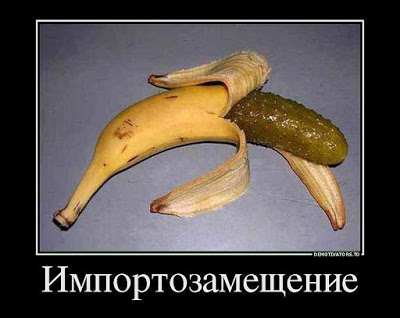
Although for Belarus this import substitution is not relevant, because ( proof + proof ) Belarus has its own bananas.
... As the main agronomist on plant protection of the Minsk vegetable factory Alexander Radushkevich told the Minsk-News agency, the bananas are harvested twice a year: in May and September. This time two branches weighing 5 kg each matured. The fruits will be given for tasting to employees of the enterprise. Miniature bananas are only 10–15 cm long. And very sweet. By the way, the plant does not use dressing and lamps for growing a miracle fruit: the plant has enough of the Belarusian sun.

Immediately I remembered
Taumatino-like proteins - the basis of sweet taste.
In addition to saponins, the peel of bananas (and the bananas themselves) contains another kind of rather unusual compounds called "thaumatino-like proteins" (English thaumatin-like proteins, TLP) and also fall into the category of "anti-nutritional substances". These proteins are short polypeptides (about 200 amino acid residues in length), resembling protein with a sweet taste in structure, thaumatin (or talin), first isolated from the raw materials of West African shrub Thaumatococcus daniellii aka African seredipipovoy he also catemfe .
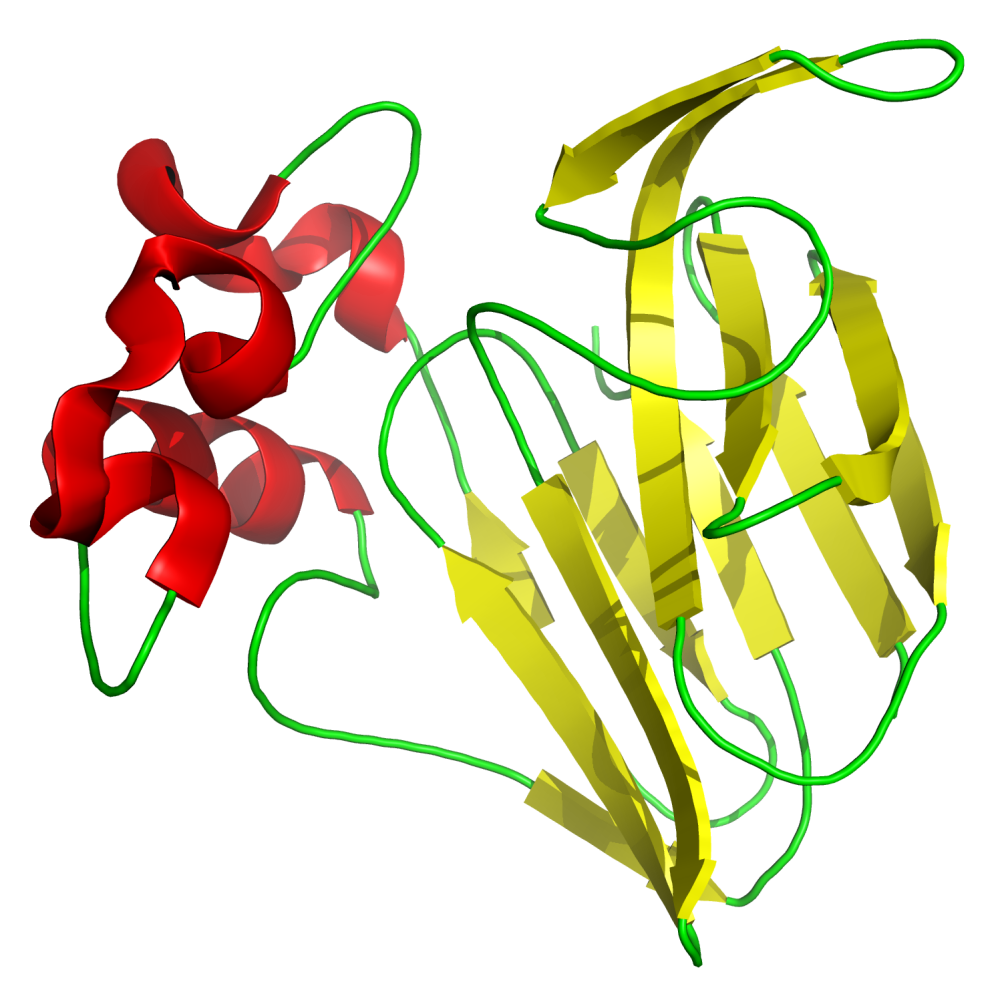
Some of the TLPs found in the plant are about 2000 times sweeter than sugar. Despite the fact that all TLPs have a very sweet taste, this taste is significantly different from the "sweetness of sugar". The feeling of sweetness comes very slowly. The sensations last for a long time, leaving a taste like licorice. Perhaps that is why thaumatin was approved as a sweetener only in the EU (E957), Israel and Japan. But in the USA it acts only as a taste corrector (FEMA GRAS 3732), but not as a sweetener.
Why did such cute things get their anti-dignity status? And for the fact that, like saponins, they protect plants from fungal damage through various mechanisms , including a sharp increase in the permeability of the cell membranes of potential pathogens and predators . Although no human studies have been conducted, experiments on cell cultures do not exclude the likelihood of increasing the permeability of intestinal tissues in humans when using TLP. So ... So people with autoimmune diseases (or with suspicion of them) should be careful when including bananas in your diet.
A barrel of honey to fly in the ointment
“Everything is poison, and nothing is poisonous; only one dose makes the poison imperceptible "(" Alle Dinge sind Gift, und nichts ist ohne Gift. Allein die Dosis macht, daß ein Ding kein Gift ist ")
Paracelsus
Once again I carry this quote (clarified, thanks to ra3vdx ) in the epigraph. And now, after reading the section on "anti-nutritional substances", it becomes even more relevant. Since all the beneficial (and healing) properties of a banana peel, whatever one may say, are associated with those same, so denounced by some Western researchers, anti-nutritional substances. But on the other hand, most of the population does not receive trace elements from plant materials (vegetarians and the raw foodists mentioned above are not included here) and can sometimes indulge in mustard, indulge in some vigorous, antioxidant fruit (and don’t think about how much zinc or iron did not have time to be absorbed).
Okay, back to our skin. I will not dwell on various artisanal and popular applications, I will briefly describe industrial areas where the banana peel found active use:
To obtain the enzyme cellulase . This enzyme is used to hydrolyze the cellulose of the cell walls of coffee beans or during the fermentation of biomass in the production of biofuels. It should be noted that cellulase is often used to treat phytobezoar (see Persimmon 2.0 Instructions for use ).
To obtain the enzyme laccase . This enzyme is known for being actively used for bioremediation and detoxification of polluted soils and wastewater. And also to improve the properties of the dough and taste of beer in the food and brewing industry. In addition, laccase class enzymes are among the few oxidoreductases widely used as industrial catalysts.
As an adsorbent for the removal of heavy metal ions from drinking water. An attentive reader will not see anything surprising, as I have repeatedly mentioned both the presence of polyphenols in bananas and banana peel, and the fact that these compounds can bind metal ions (copper, zinc, etc.) to form complexes. Brazilian environmentalists have once again confirmed this fact, using dried and chopped banana peel for water purification. At the same time, 10 minutes is enough for cleaning (
to drink once), and the device itself for water purification, seasoned with banana peel, can be used up to 11 times, keeping all TTX.All the antibacterial properties of the peel fit well into the properties typical of tannins. The only clarification about "how it works." Polyphenols directly work with their ability to bind to bacterial proteins, or components formed after enzymatic conversion. The picture shows the mechanism by which hydrolyzable tannins degrade to the simplest metabolites. And metabolites, in turn, actively interact with pathogenic bacteria. The same, resorcinol, for example, is a widely used drug in the treatment of skin diseases.

- Those saponins, which are harmful if taken orally, work remarkably as an analgesic and anti-inflammatory agent (the effect on leukotrienes in the metabolism of arachidonic acid). Banana skins are a very good remedy for insect bites - they easily relieve irritation and reduce swelling (especially if there are no more effective remedies at hand)
Conclusions : banana peel - if it is not particularly edible, it can sometimes be useful for many life hacking. Some I even described. So, health to all habr-readers and Merry Christmas!
Sergey Besarab ( Siarhei V. Besarab )
-Moser, S., Müller, T., Ebert, M.-O., Jockusch, S., Turro, NJ, & Kräutler, B. (2008). Blue Luminescence of Ripening Bananas. Angewandte Chemie International Edition, 47 (46), 8954–8957
-Singh, B and Bhat, TK (2003) Potential plant secondary metabolites. Journal of Agriculture and Food Chemistry 51: 5579-5597
-Brooks, AA (2008). Ethanol production of local banana peels isolated from ripe banana peels. African Journal of Biotechnology 7: 3749-3752.
-Ratule MT, Osman, A., Saari, N. and Ahmad, SH (2007). Microstructure of peel cell wall and selected physic-chemical characteristics of Berangan banana (Musacv. Berangan [AAA]) ripened at high temperature. Asia Pacific Journal of Molecular Biology and Biotechnology 15: 8-13.
-Mokbel, M., Saif, F. and Hashinaga, F. (2005). Antibacterial and antioxidant activities of banana (Musa, AAA cv. Cavendish) fruits peel. Asian Journal of Biotechnology 2: 1-4
-Adeniji TA, Sanni LO, Barimalaa IS, Hart AD. Anti-nutrients and banana cultivars. Nigerian Food J 2007; 25: 165-170.
–Choehom, R., Ketsa, S., & van Doorn, WG (2004). Atmosphere packaging. Postharvest Biology and Technology, 31 (2), 167–175.
http://agris.fao.org/agris-search/search.do?recordID=US9710952
-Bico, SLS, Raposo, MFJ, Morais, RMSC, & Morais, AMMB (2009). This is a combination of the caringenan dip and / or carved out . Food Control, 20 (5), 508-514.
-Hirsch, AR, and R. Gomez. "Weight Reduction Through Inhalation of Odorants." J Neurol Orthop Med SufI 16 (nd): 28-31. Web. 1 Mar. 2015
https://www.researchgate.net/publication/284455351_Antibacterial_and_phytochemical_analysis_of_Banana_fruit_peel
—Odebiyi, OO and Sofowora, EA (1978) Phytochemical Screening of Nigerian medicinal plants part II. Lloydia 41 (1): 234-235
—Liu, J.-J., Sturrock, R., & Ekramoddoullah, AKM (2010). The superfamily of thaumatin-like proteins: biological culture. Plant Cell Reports, 29 (5), 419–436.
')
Source: https://habr.com/ru/post/434944/
All Articles